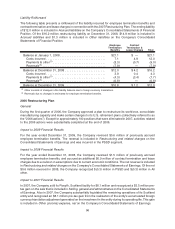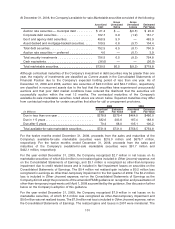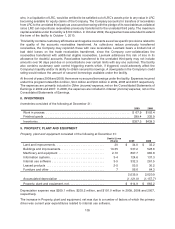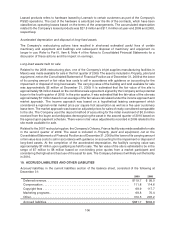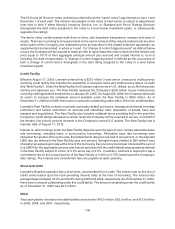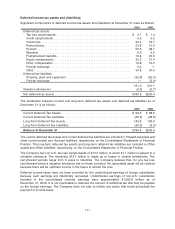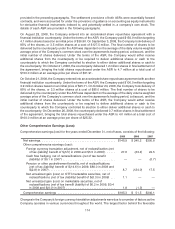Lexmark 2009 Annual Report Download - page 110
Download and view the complete annual report
Please find page 110 of the 2009 Lexmark annual report below. You can navigate through the pages in the report by either clicking on the pages listed below, or by using the keyword search tool below to find specific information within the annual report.
securities until liquidity in the market or optional issuer redemption occurs, and it is not more likely than not
that the Company will be required to sell these securities before anticipated recovery. Additionally, if
Lexmark required capital, the Company has available liquidity through its accounts receivable program
and revolving credit facility.
Corporate debt securities
Credit losses for the Company’s corporate debt securities are due to its holdings in certain Lehman
Brothers medium term notes. Lehman Brothers Holdings Inc. filed a petition for bankruptcy in September
of 2008 seeking relief under Chapter 11 of the United States Bankruptcy Code. In order to determine the
cash flows expected to be collected the Company considered certain drivers that centered on determining
the value of the underlying assets, the likelihood of residual proceeds after all amounts owed are settled
with creditors, and the timeframe in which this may occur. Any unrealized losses on the Company’s
remaining corporate debt securities are attributable to market illiquidity and interest rate effects and are not
due to credit quality. Because the Company does not intend to sell and will not be required to sell the
securities before recovery of their net book values, which may be at maturity, the Company does not
consider the remainder of its corporate debt portfolio to be other-than-temporarily impaired at
December 31, 2009.
Asset-backed and mortgage-backed securities
Credit losses for the asset-backed and mortgage-backed securities were derived by examining the most
significant drivers affecting loan performance such as original loan-to-value ratio, underlying property
location and current loan status. These drivers were further divided in order to separate the underlying
collateral into distinct groups based on loan performance characteristics in order to apply different
assumptions to each group. For instance, higher default curves were applied to higher risk categories
such as collateral that exhibits higher loan-to-value ratios, those loans originated in high risk states where
home appreciation has suffered the most severe correction, and those loans which exhibit longer
delinquency rates. Based on these characteristics, collateral-specific assumptions were applied to
build a model to project future cash flows expected to be collected. These cash flows were then
discounted at the current yield used to accrete the beneficial interest, which approximates the
effective interest rate implicit in the bond at the date of acquisition for those securities purchased at par.
U.S. Treasury and Government Agency securities
The unrealized losses on the Company’s investments in U.S. Treasury and U.S. government agency
securities were the result of interest rate effects. Because the Company does not intend to sell the
securities and it is not more likely than not that the Company will be required to sell the securities before
recovery of their net book values, the Company does not consider these investments to be
other-than-temporarily impaired at December 31, 2009
7. TRADE RECEIVABLES
The Company’s trade receivables are reported in the Consolidated Statements of Financial Position net of
allowances for doubtful accounts and product returns. Trade receivables consisted of the following at
December 31:
2009 2008
Gross trade receivables . . . . . . . . . . . . . . . . . . . . . . . . . . . . . . . . . . . . . . . . . . . . $458.6 $463.4
Allowances . . . . . . . . . . . . . . . . . . . . . . . . . . . . . . . . . . . . . . . . . . . . . . . . . . . . . (33.7) (36.1)
Trade receivables, net . . . . . . . . . . . . . . . . . . . . . . . . . . . . . . . . . . . . . . . . . . . . . $424.9 $427.3
In the U.S., the Company transfers a majority of its receivables to its wholly-owned subsidiary, Lexmark
Receivables Corporation (“LRC”), which then may transfer the receivables on a limited recourse basis to
an unrelated third party. The financial results of LRC are included in the Company’s consolidated financial
results since it is a wholly owned subsidiary. LRC is a separate legal entity with its own separate creditors
104




